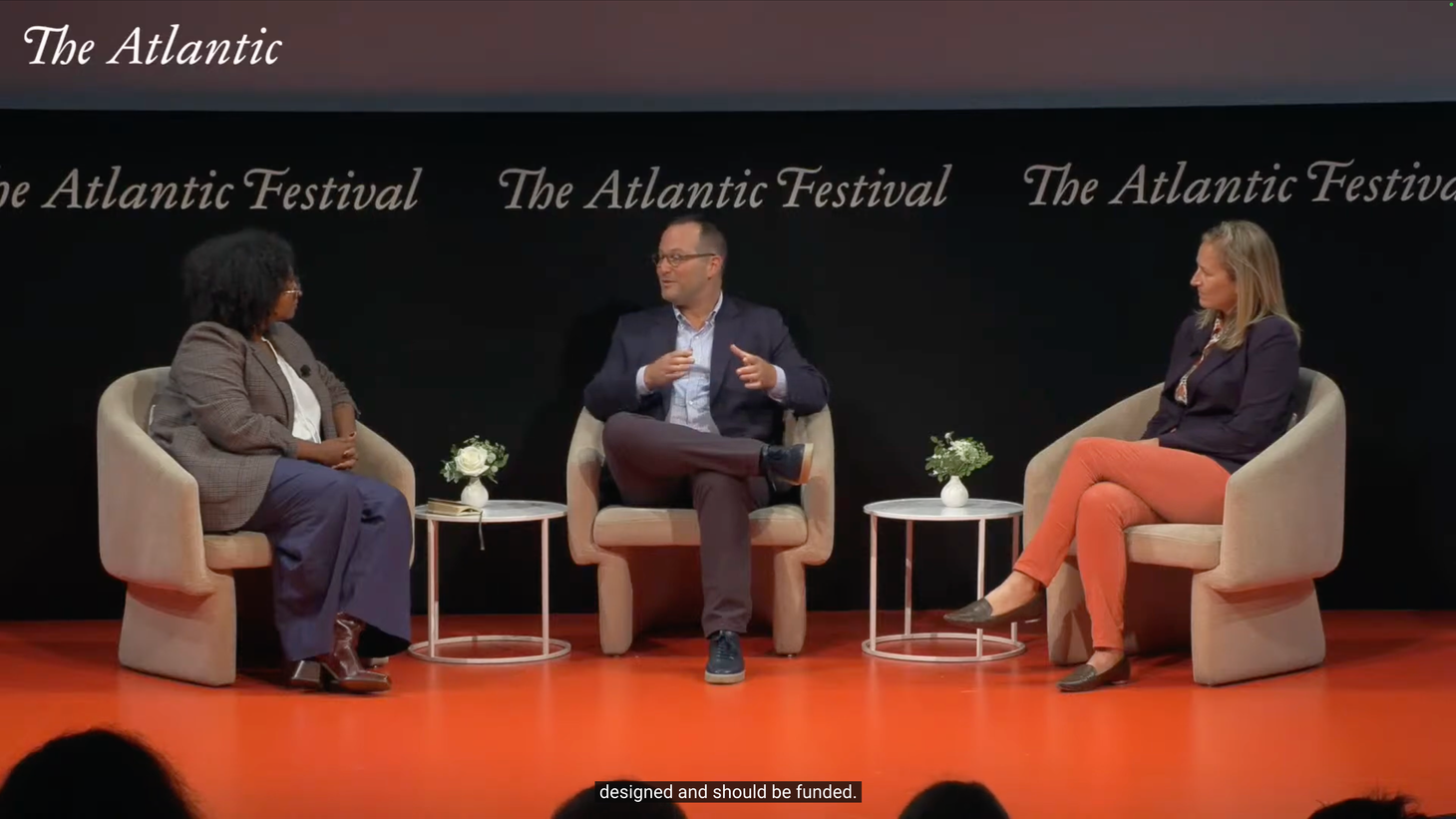Panel: Dror @ The Atlantic Festival
Five thoughts about the future of cities.

Last week, I joined a panel at The Atlantic festival to chat with Jerusalem Demsas and Diana Lind about the prospect for cities in a new age of work. Below is a recording and a summary of the main points, courtesy of ChatGPT (with some editing).
1. Complacency and Denial Are Holding Cities Back
Dror argues that many cities are stuck in outdated paradigms, clinging to pre-COVID models that no longer serve modern needs. According to him, COVID merely exposed long-brewing problems in urban infrastructure and planning.
There's still a lot of complacency and denial in trying to hold on to the previous paradigm. Some fundamental drivers of how cities should look, how they should be designed, how they should be funded, and even of their basic purpose have changed quite substantially. This did not happen because of COVID, but COVID kind of laid it bare and expedited it. A lot of cities are still in denial about it. They still make it very hard for their businesses and residents to adapt to what they actually need.
And from a purely technical perspective, a lot of the damage that was caused by COVID is going to unfold quite slowly: Most of the office leases that were signed pre COVID have not come up for renewal yet. There's still a lot of downsizing coming up, with effects on retail and on housing decisions and on municipal budgets. My pessimism is mostly about the complacency and denial, not about the lack of ability or the lack of importance of cities.
Cities, Dror suggests, are failing to adapt quickly enough, making it harder for businesses and residents to adjust to the realities of a post-pandemic world. This rigidity could lead to further economic disruptions unless cities shake off this denial.
2. The Office Crisis Needs Another Shock to Resolve
Dror highlights a critical issue facing cities: the slow-burning crisis in commercial real estate, particularly in office spaces. Despite the initial hit from COVID, the full impact on office space hasn't been felt yet, as many leases signed pre-pandemic have not yet come up for renewal.
Consider the retail crisis of the 2010s. We had 25 years to prepare for ecommernce. Everyone was talking about ecommerce. And yet, until COVID, you still had many empty stores asking for higher rents and pretending that someone will one day come and pay for them.
The lenders of those buildings also wanted to pretend that one day someone will come and pay for them. The tax collectors also wanted to pretend that someone, one day someone will come and pay for them. Until there was a real crisis that helped clear the market, no one let go. COVID started a crisis for office, but we'll need another external shock to help finish the crisis.
This means that while the COVID crisis initiated the decline, another disruptive force—likely economic or technological—will be needed to fully address the oversupply of office space and its ripple effects on cities.
3. Cities Are Booming and Struggling Simultaneously
One of the paradoxes Dror points out is that cities can thrive economically while simultaneously being in crisis. This unusual dynamic shows that something fundamental has changed in how our economy and urban centers function.
One part of the paradox that we're experiencing is that people want to live in cities and cities are in trouble at the same time. They're booming economically and they're in trouble at the same time. It's quite unusual and shows us that something changed in the way our economy actually functions.
We can have an all time high in the stock market. We have an AI boom in San Francisco, and yet overall employment in San Francisco is lower today than it was pre-COVID. And if you follow the trend in terms of employment growth, it's about 12% percent below trend. About 25\-30% of office space is unleased, let alone the additional space that is empty.
Many people actually want to live in cities, and if they can live anywhere, we're seeing in New York that more people are actually wanting to live in Manhattan and in New York than before, so apartment rental costs and buying costs are actually higher than ever, while offices are struggling.
The problem is that to accommodate that demand, cities have to build more housing, they have to allow more office conversions, they have to allow people to experiment more in terms of what they build, they have to make construction faster, they have to take the uncertainty out of it. So that if people are experimenting and willing to take a bet on those cities, whether it is in terms of moving there or investing and building there, that it will be a little easier for them.
Even as urban centers like San Francisco experience AI booms, they face declining employment and vacant office spaces, revealing the disconnect between economic growth and population trends.
4. Cities Need Flexibility and Experimentation
Dror believes that one of the key failures of modern cities is their inability to accommodate the new economy. Cities must shift from rigid, office-centric planning to more flexible environments that encourage experimentation—whether in housing, retail, or workspace design.
The cities we need are much more mixed, much more livable, and much more of a field for experimentation, which is something that you can do in the city quickly.
...a hundred-something years ago, we started zoning our cities under the assumption that as planners, we have a very clear view of what's going to happen in which areas during which hours of the day. We survived partly the transition from an industrial economy to an office based economy because the office based economy that we had in 1950, 1960 was very much like the industrial economy. It still relied on like masses of people that had identical education, identical incomes, clear schedules.
But for a while now, our economy has not behaved like that. Through the force of inertia, our cities still managed to accommodate the way we work. But COVID flipped the question on its head, and instead of asking, "why should you work from home?," we're starting now from zero and say, Okay, "why should I come back here? Why should I work like this at all? Why should I renew my lease now that I have other options?" So we have we need cities that can accommodate the actual economy that we have not the one we had fifty years ago.
the purpose of a city, among other things, is to lower transaction costs for everyone, to allow people to find whatever they need, ad hoc, on demand, try it, and if it works, do more of it, and if it doesn't work, do less of it.
By loosening zoning restrictions and allowing for greater flexibility, cities can better serve the needs of businesses and residents in this era of rapid change and uncertainty.
5. The Future of Work Will Be Distributed
Finally, Dror points to a broader trend already underway before COVID: the rise of distributed workforces. The pandemic accelerated this, but the deeper issue is not just about remote work—it’s about decentralizing core business activities across multiple locations.
the bigger story is not remote — "should I work in bed or should I work at an office" — but the redistribution of work. Even before COVID, the most innovative, fastest growing companies started to hire from larger pools of talent in order to match in order to get cheaper talent in order to fit the right person to the right job. And they showed the preference to split their core activities to five or ten different locations. And once you saw that happening, you could ask, okay, so why shouldn't it be 50 locations? So it's more about people moving with their high paying jobs to all sorts of places rather than simply working from home. I don't think these people mind going to an office if there's an office nearby
This new model of distributed work will continue to shape cities, economies, and even how businesses hire and organize talent. Rather than reverting to old models, Dror suggests that cities must align themselves with this new reality to thrive.
Conclusion
Dror’s insights offer a sharp, forward-looking critique of how cities are currently operating and what needs to change. He highlights a mismatch between the old urban models and the new economic realities. As cities face challenges like vacant offices and distributed workforces, flexibility, experimentation, and a rejection of complacency will be key to navigating the future.
By embracing these ideas, cities can transform themselves from rigid, outdated infrastructures into dynamic hubs that reflect the complexities and opportunities of the modern world.
P.S.
I recently started posting short videos on LinkedIn with quick takes on current events, such as Amazon's 5-day-at-the-office mandate, why CEOs should be honest about cutting headcount, why lower interest rates would prolong the office crisis, and how come Google spent $2.7 billion to rehire one of its AI engineers. Some of these already got millions of views, so do check them. And if you're not yet following me on LinkedIn and Twitter, please do.
Have a great weekend,

🎤 Are you looking for a keynote speaker for your next event, corporate offsite, or investor meeting? Every year, I inform and inspire thousands of executives across the world. Visit my speaker profile to learn more and get in touch with my agent.
Dror Poleg Newsletter
Join the newsletter to receive the latest updates in your inbox.

